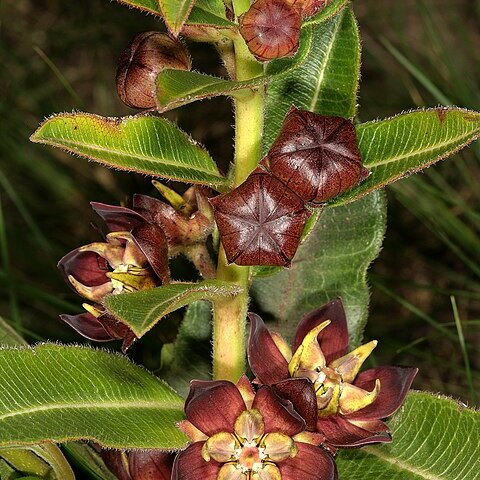Stem 210-660(-920) mm tall, slender to stout, erect or ± decumbent, branched at the base or unbranched, puberulous to densely pubescent or ± scabrous. Leaves ascending-spreading, petiolate or subsessile; petioles 1-10(-15) mm long; blade 43-125(-147) x 4-40 mm broad, linear, lanceolate, narrowly elliptic, narrowly oblong, oblong-lanceolate, elliptic-lanceolate, elliptic-oblong or narrowly ovate, margins flat or undulate, scabrous or pubescent, surfaces puberulous to pubescent or ± scabrous, midrib scabrous. Inflorescence umbellate, (1-)2(-3)-flowered, sessile at the nodes or terminal, lowermost rarely pedunculate, sometimes with two inflorescences at a node,-one sessile and the other shortly pedunculate; peduncles 0-10(-20) mm long. Bracts 3-14(-18) mm long, linear, acute or acuminate, pubescent below. Pedicels (5-)10-20 mm long, ± puberulous to densely pubescent. Sepals 7.0-8.0 x 3.5-7.5 mm, lanceolate, narrowly ovate, ovate elliptic or narrowly elliptic, apex acute or acuminate, glabrous above or ± scabrous towards apex, pubescent below. Corolla 11-25 mm long, broadly cup-shaped or ± campanulate, lobed ± to the base, purple-brown with tips tinged dull yellow or green or yellowish-cream or green with brown-pu[r]ple spots or with tips tinged purple; lobes 8-22 x 6-14 mm, ovate, elliptic-oblong or broadly elliptic, tips acute or subacute, recurved or slightly incurved, margins imbricate below, glabrous above, glabrous to scaberulous or slightly pubescent below. Corona lobes 5-14 mm long, spreading horizontally at the base and there suborbicular, subrhomboid, rhomboid or subquadrate, or more rarely narrowly ovate to lanceolate, 2.5-6.0 mm broad, with a pair of erect, fleshy contiguous keels, keels 1.0-4.0 mm high, 1.4-5.0 mm long, subfalcate, deltoid or ± oblong; lobe beyond the keels inflated into a linear, linear-lanceolate, narrowly ovate or narrowly elliptic blade 1.2-5.4 mm broad, obtuse or rarely minutely tri-lobed, erect or incurved over the keels, dull green or yellow, often tinged purple at the base or apparently pale chocolate tipped dull yellow. Anther wings 2.0-5.0 mm long, oblique, outer margin straight or slightly concave with basal angles diverging and curving outwards; appendages 1.2-3.0 mm long, orbicular or broadly ovate, subacute tips indexed over and covering the style apex. Follicle 63-107 x 28-33 mm, narrowly ovoid, narrowing towards the truncate apex, winged, glabrous.
More
A herb. It keeps growing from year to year from a cylinder shaped tuber by producing annual stems. There can be one or several stems and they can be erect or lie along the ground. They sometimes branch near the base. They can be 1 m tall. They are hairy. The leaves are opposite. They are oval or narrowly sword shaped. They are 16 cm long by 4 cm wide. There are hairs on both surfaces. The flowers are in groups of 1 to 7 near the top of the stems. The flowers have a scent. The flowers are bell shaped and reddish-brown outside and white or pink inside. The fruit is an erect sac on a twisted stalk. It can be 12 cm long by 3 cm wide. There are 6 ridges along it.
Erect or decumbent perennial herb, 0.21-0.66(-0.92) m high. Leaf margins flat or undulate. Inflorescence (l)2(3)-flowered; lowermost inflorescence sessile or subsessile. Corolla broadly cup-shaped or ± campanulate. Corona lobes with a pair of short, erect, fleshy, contiguous keels, subfalcate, deltoid or ± oblong. Flowers purple-brown with tips tinged dull yellow or green or yellowish cream or green with brown-purple spots or with tips tinged purple; corona dull green or yellow, often tinged purple at base.

